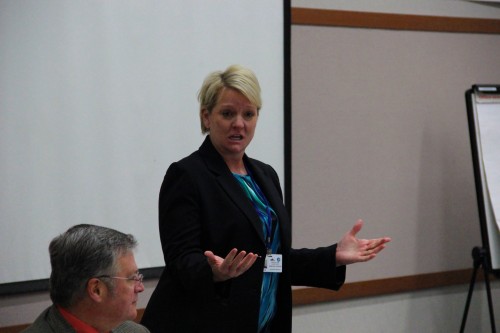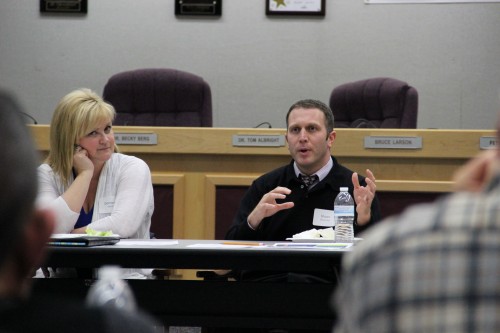
Marysville School District Superintendent meets with teachers, staff, and legislators
Article and photo by Andrew Gobin
Marysville – The structure of the school day may be changing. There is a discussion at the capitol in which Washington State Legislators are considering lengthening the school day and adding 80 hours to the 1000-hour yearly quota class instruction time. Dr. Becky Berg, superintendent for the Marysville School District (MSD), invited legislators, community leaders, administrative staff, and members of the teaching faculty to come together on January 6th to discuss the needs of the schools, specifically addressing the 6-hour day and 1080, reforms to the school day that are currently being discussed in Washington State. The meeting also emphasized the need to pass the levy this year.
The 6-hour day and 1080 discussion, as it is called, would lengthen the school day to include 6 hours of instruction time, as opposed to the 5.5 required now, and would add another 80 hours a year to the time teachers and students are required to spend in the classroom together. Consequently, the proposed changes do away with early release days and teacher workshops.
“We (teachers) rely on early release days to come up with time for collaboration and professional development. Enough with reform, if change needs to happen it needs be on a local level. People at the capitol don’t have the answers. People in D.C. don’t know what we need,” said Arden Watson, president of the Marysville Education Association.
Getchell High School Principal Shawn Stevenson agreed, “When you ask teachers what they need, more than anything they need time. Time to be proficient in their job, time to develop a teaching plan, and time to adjust and rework that plan so that students can succeed.”

Jodi Runyon, executive assistant to the MSD Superintendent, echoed, “With funding from the SIG grants, Quil Ceda and Tulalip elementary staff had the resources and freedom to redesign their schools. They were able to create planning time throughout the school day. Now they have enormous student success, which has recently been recognized on a national level. The only question now is where do we find the funding as the SIG grant has come to an end.”
The SIG grant is a three-year federal funding program for schools in need, which culminated this last November with a visit for the President of the National Education Association.
In addition to time for teacher planning and development, the levy was strongly emphasized as a crucial component for the MSD. For example, the technology aspect of the levy will help students and teachers access a state of the art fiber-optic network that is already in place district wide. The problem is there are no points of access. The infrastructure is there, yet the classrooms are not equipped to engage with the network. Currently, it is compared to a freeway with no on ramp. No one has access.
“It goes beyond the school day. At sporting events and after school hours, our Wi-Fi will be open to those at the school. Free Wi-Fi for parents and students, filtered of course, so to eliminate problems of access at home,” said Berg.
Dean Ledford called the levy “paramount to the success of teachers and students.”
The legislators and leaders that attended included Washington State Representatives Mike Sells and Hans Dunshee, Snohomish County Executive and former Snohomish County Sheriff John Lovick, Senator John McCoy, 189 Educational Service District Superintendent Jerry Jenkins, former Mayor of Marysville Dennis Kendall and current Mayor Jon Nehring. They all offered support for what the teachers and staff of the MSD are trying to do, sharing similar concerns about the 6-hour day and 1080 discussion.
